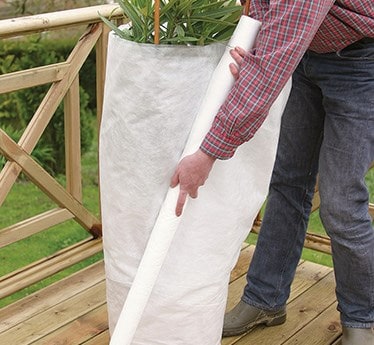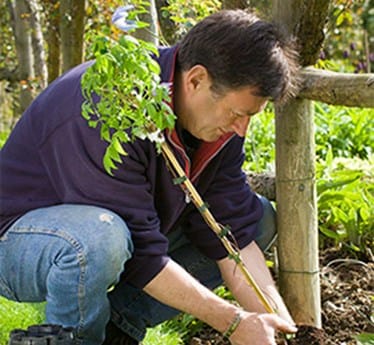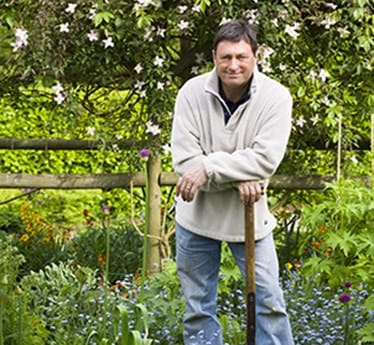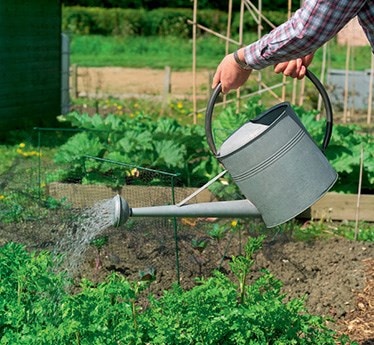What to do before a storm
- Remove broken or damaged branches from trees
- Check fence posts and panels are secure
- Move top-heavy containers to a sheltered spot
- Check plant supports are in good repair
- Take down hanging baskets
- Check tree stakes and ties are firm
- Store garden furniture and other equipment
- Make repairs to sheds and other garden structures
Preventing wind damage
Trees
Not surprisingly, trees are the most at risk from high winds, especially when they are still in full leaf. It’s worth checking mature trees at this time of year to see if there are any tell-tale signs of trouble, such as bracket fungi around the base or evidence of damage further up the trunk or in the crown. Bracket fungi are a sure sign of fungal decay in the heartwood of standing trees and should not be ignored. Also look for broken limbs from summer storms, as well as any dead or dying branches.
Where there’s neighbouring trees overhanging your plot, check these, too. If you are at all worried about a tree, seek professional advice either from a qualified tree surgeon or contact the tree officer at your local authority who will be able to point you in the right direction. Some types of tree are much more prone to winter gales than others. Robinia, for example, has very brittle branches that can easily snap during stormy weather.
Birches, on the other hand, have a reputation for blowing over in a gale, while mountain ash tends to produce branches that form a narrow angle to the main trunk which are prone to splitting away in very windy weather. Very old specimens of any species of tree and those that have had their roots damaged by recent building works are particularly at risk of toppling in a storm. Young trees can be damaged by gales too. Check that the stake and tie are secure and not rubbing – making adjustments at necessary. If a young tree gets blown over, prop it up and re-stake it or replant it where practicable.
Shrubs
Although most shrubs will shrug off winter gales, a few are vulnerable to damage. Fast- growing shrubs, such as Buddleja and Lavatera, have long, brittle woody shoots that can break in severe storms. You can prevent this from happening by pruning all the shoots back by about one-third.
Tougher tall shrubs, such as roses, can suffer from wind-rock when buffeted by winds. On some soils, this can cause a hollow to form in the soil around the base of the stem as the plant is rocked back and forth by the wind. If left, the hollow may fill with water resulting in crown-rot. Again, this can be prevented by pruning the roses back beforehand, and re-firming the soil around affected plants after a storm.
Climbers
Some vigorous climbers, like wisteria, will put on a lot of growth during the spring and summer which is vulnerable to damage in windy weather. Others, such as clematis, become top-heavy with a mass of interwoven stems that act like a sail when the wind blows – putting their support under enormous strain.
A little judicious pruning is the solution – check in a good gardening book or online, to make sure you do this correctly for the climber you are tackling. Otherwise, you might risk missing out on flowers next year. The supports of all climbers also should be checked to make sure they’re in good shape and the climber is securely attached. Tie in new growth if necessary.
Garden structures
Give fences a vigorous wiggle to make sure they are still firm and make any repairs to panels and replace post caps as necessary. I always give the base of fence posts a prod with a screwdriver to test for signs of rot. If the post is suspect or completely rotten through, it will either have to be replaced or sawn-off at ground level to remove the rotten portion before mounting in a metal fence spike.
If you don’t fancy removing the post, you could add a proprietary concrete spur to one side, and bolt the post on securely. Any wooden structures, such as pergolas and arches that are in direct contact with the soil will rot in time. These, too, should be checked for signs of rot and weakness and repaired as necessary.
Garden sheds and greenhouses are particularly vulnerable to high winds. Inspect and reinforce the roof and walls of an old shed if required and check the cross-bracing in greenhouses is in good order. In exposed gardens, it is also a good idea to secure sheds and greenhouses to their base and replace cracked and missing panes of glass. Also replace missing glazing clips and close all vents and doors if stormy weather is forecast.
Coping with winter wet
Heavy downpours rarely cause damage during the winter months unless associated with poor drainage. Although most plants can cope with wet soil for a few weeks, if it remains waterlogged for longer than this, you may need to take action. Any long-term solution will require putting in land drains and improving heavy soils with grit and well-rotted manure to aid drainage. Or you could try planting on mounds and in raised beds filled with good-quality top-soil to alleviate the problem.
In permanently wet areas, use plants that are well adapted to boggy soil. Prolonged wet spells can adversely affect susceptible plants even where the soil drains well. Alpines and grey-leaved plants can easily rot over the winter if they remain wet. You can protect them by placing a horizontal pane of glass over them, sandwiched between stacks of bricks, or make a polythene plant-port (a miniature version of a car-port) held on wire legs made out of an old wire coat-hanger.
The lovely winter flowers of hellebores are easily damaged by mud-splash, so if you want some for indoor arrangements, cover plants with open-ended cloches now to preserve their flowers in pristine condition.
Dealing with frost and snow
Heavy falls of snow can cause damage to mature garden plants, breaking limbs and pulling conifers and other evergreens as well as hedges out of shape. In addition, accumulations of snow on flimsy structures, such as fruit cages, can cause them to collapse. The curious thing about snow is that it gets a lot heavier as it starts to thaw, so if you can get out in your garden and knock the fresh snow off you can prevent damage being done. Prized columnar conifers can be kept in shape by wrapping them in fine-mesh netting before the snow falls. You can even leave the netting in place all year round since new growth will sprout through the netting and hide it completely.
When the temperature plummets in winter, borderline hardy plants are at risk and will need protecting (see Wrapping up for winter). Severe and persistent frost can damage even hardy plants. If a severe frost is followed by a rapid thaw during the day this can cause even more problems – splitting bark of established trees and shrubs and damaging delicate early blooms, such as camellias. Also, the rootballs of new plants can be lifted by severe frost and may need to be re-firmed once the ground thaws out.
Clearing up after a storm
Gardens are resilient things and even if yours looks a bit of a wasteland after a storm, it won’t take long before it’s back in shape. Serious irreversible damage, such as toppled trees and broken limbs, will need to be given priority, especially if they represent a hazard or are blocking access. If the tree belongs to you, this can be expensive and is rarely covered by normal household insurance - unless it is specified in the fine-print. Do not take unnecessary risks. Always consult a qualified tree surgeon to tackle mature trees, because they will have the expertise and necessary third-party insurance cover to carry out such work.
My top tip here is that if you have trees in your garden, get them inspected now by a professional tree surgeon - you will then have a telephone number you can contact in case of emergency. After a storm, all tree surgeons become inundated with work, but are more likely to prioritize their existing clients. If you do not know of a reputable professional tree surgeon in your area, contact the tree officer at your local authority who should be able to provide you with a list.
If your tree has a Tree Preservation Order on it, check with the local authority before carrying out any work – again a qualified tree surgeon will be able to advise you on this. Most other garden repairs can be carried out over time and when weather permits, but have a chat with neighbours before tackling repairs to party walls and fences.















